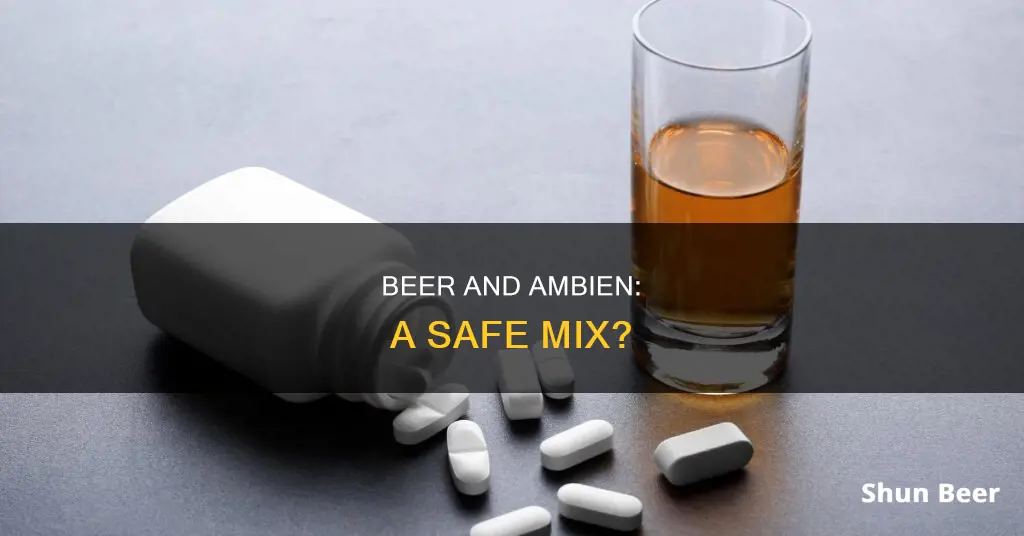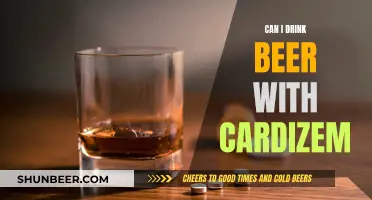
Mixing alcohol and Ambien can be extremely dangerous and even life-threatening. Both substances are central nervous system depressants, and when taken together, they amplify each other's effects, leading to a higher risk of overdose and even death. It is recommended to wait at least 24 hours after drinking alcohol before taking Ambien to avoid any potential drug interactions and harmful side effects. This is because alcohol can last in the system for several hours, and mixing the two can result in a dangerous combination of their sedative effects.
| Characteristics | Values |
|---|---|
| Mixing Ambien and alcohol | Dangerous |
| Why it is dangerous | Both are central nervous system depressants, which can lead to an overdose |
| Side effects | Lack of motor control, worsening drowsiness and dizziness, cardiovascular problems, and breathing cessation |
| When can you take Ambien after drinking? | It is recommended to wait at least 24 hours after your last drink before taking Ambien |
What You'll Learn

Side Effects of Mixing Alcohol and Ambien
Mixing alcohol and Ambien can lead to a variety of side effects. Both substances are central nervous system depressants, which means that their side effects can combine to lead to worse symptoms. Even at low doses, these effects can include:
- Lack of motor control
- Worsening drowsiness and dizziness
- Cardiovascular problems
- Breathing cessation
- Problems concentrating
- Loss of consciousness
- Coordination difficulties
- Parasomnias like sleep driving
- Increased risk of injury or harm from parasomnia behaviours
- Disinhibition and high-risk behaviour, including suicidal behaviours
- Increased risk of addiction
- Higher risk of overdose
- Worse withdrawal symptoms
Because both substances slow down brain function and cause sedation, mixing alcohol and Ambien intensifies these depressant effects. This can lead to an overdose, where heart rate and breathing slow and potentially stop altogether.
The combination of alcohol and Ambien can also increase the risk and severity of other Ambien side effects, including injury from confusion, sedation, and impaired cognition and motor coordination.
It is recommended to wait at least 24 hours after your last drink before taking Ambien. This is because alcohol can last in your system for hours, peaking within 45 minutes after a drink and slowly wearing off in the hours that follow. It takes about 20-25 hours for alcohol to completely leave your bloodstream.
Treatment for Polysubstance Use
If you are dealing with alcohol addiction and misusing Ambien, there are different levels of care available, including detoxification, inpatient or long-term residential treatment, intensive outpatient treatment programs, and outpatient counselling. It is important to seek help if you are struggling with addiction to either substance, as prolonged Ambien and alcohol misuse can be hazardous and even fatal.
Near Beer After Neuropathy: Is It Safe?
You may want to see also

Dangers of Mixing Zolpidem and Alcohol
Mixing zolpidem (Ambien) and alcohol can lead to a variety of side effects and health risks. Zolpidem is a sleep medication that is used to treat insomnia. It is a sedative-hypnotic drug that works by slowing down brain activity, making it easier to fall and stay asleep. Alcohol is also a central nervous system depressant that can have similar effects on the brain and body.
When zolpidem and alcohol are mixed, it can lead to an increase in side effects such as problems concentrating, coordination difficulties, drowsiness, and dizziness. The mix can also increase the risk of complex sleep activities such as sleepwalking, sleep eating, and sleep driving, which can be dangerous and put individuals at risk of accidents or injury.
One of the most serious dangers of mixing zolpidem and alcohol is the increased risk of overdose. Both substances are depressants and can have synergistic side effects, leading to a higher risk of ICU admission when combined. Additionally, mixing zolpidem and alcohol can slow heart rate and breathing, which can be potentially fatal.
Another concern is the increased risk of addiction when combining these two substances. Zolpidem is a federally controlled substance with a risk of abuse, dependence, and addiction. Combining it with alcohol, which is also addictive, may increase the overall risk of addiction and make it more difficult to quit.
Withdrawal symptoms from zolpidem and alcohol can also be worse when the two substances are mixed. Both can cause withdrawal symptoms after a single use, and taking them together can lead to more severe next-morning symptoms.
It is important to note that individuals should never drink alcohol and take zolpidem in the same evening. Alcohol can last in the system for hours, and mixing it with zolpidem can lead to dangerous consequences. If you are taking zolpidem, it is best to skip your dose for the night if you have consumed alcohol earlier in the evening or before bedtime.
If you struggle with zolpidem and alcohol addiction, it is important to seek professional help. Treatment options are available, including medical detox, rehab, and therapy, to help individuals safely quit and develop skills to stay off these substances.
Beer and Driving: Safe After One?
You may want to see also

Increased Risk of Overdose
Mixing Ambien and alcohol is extremely dangerous and can lead to an increased risk of overdose. Both substances are central nervous system depressants, which means they slow down the heart rate and respiratory system. When taken together, the side effects of both Ambien and alcohol are amplified, and the risk of overdose increases. This is because the substances have synergistic side effects, meaning that the depressant effects are exponential when mixed rather than linear.
The risk of overdose is heightened when Ambien is combined with alcohol due to the increased presence of the drug in the body. This can lead to cardiovascular problems and respiratory suppression, which can be life-threatening. Studies have shown that mixing Ambien with alcohol leads to a higher risk of ICU admission than taking Ambien alone, even when the drug is taken at higher-than-recommended doses.
The combination of Ambien and alcohol can also lead to other dangerous side effects, including lack of motor control, worsening drowsiness and dizziness, and increased risk of injury or harm from parasomnia behaviours such as sleepwalking, sleep eating, and sleep driving. The risk of developing an addiction is also increased when these two substances are mixed, as they are both potentially addictive.
To avoid the risk of overdose and other dangerous side effects, it is recommended to wait at least 24 hours after drinking alcohol before taking Ambien. This is because alcohol can last in the system for several hours, slowly wearing off over time. It is also important to follow the instructions provided by a doctor or pharmacist when taking Ambien, as they can provide specific advice based on an individual's medical history.
Exploring Fort Myers Beach: Beer and Beyond
You may want to see also

It Can Make Withdrawal Symptoms Worse
Mixing Ambien and alcohol is never safe and always carries a risk of overdose. Both substances are central nervous system depressants, which means that when taken together, their effects are not just additive but exponential. This is known as a pharmacodynamic drug interaction, where the sedative effects of one drug add to the sedative effects of the other.
The dangers of mixing Ambien and alcohol include a higher risk of sleep activities like sleepwalking, sleep eating, and sleep driving, as well as a slower heart rate and breathing, which can be fatal. The combination can also lead to a higher risk of addiction, overdose, and worse withdrawal symptoms.
If addiction does develop, polysubstance abuse, or the abuse of multiple substances, can complicate the detox process and necessitate more medical care. A study by The Recovery Village found that polysubstance abuse increased the likelihood of experiencing more dangerous or severe withdrawal symptoms during alcohol detox. Compared to respondents who were only detoxing from alcohol, people detoxing from alcohol and at least one other substance were:
- 2.14 times more likely to experience Delirium tremens (DT)
- 2.25 times more likely to experience seizures
- 1.6 times more likely to experience hallucinations
Because of the serious withdrawal symptoms associated with Ambien and alcohol, people who abuse these drugs should seriously consider starting their Ambien addiction treatment with a safe and supportive medical detox program.
Beer and Keppra: Is It Safe to Drink?
You may want to see also

Treatment for Polysubstance Use
Mixing Ambien and alcohol is dangerous and can lead to a host of side effects and health risks. Both substances are central nervous system depressants, and their effects are compounded when taken together. The combination can lead to a higher risk of overdose, as well as more severe withdrawal symptoms. It is never safe to mix the two, and doing so can be life-threatening.
Polysubstance use refers to the consumption of multiple substances, whether illicit drugs, prescription medications, or alcohol, simultaneously or over a defined period. It is a complex issue that requires specialized treatment. Here are some key aspects of treating polysubstance use:
- Detoxification: Detox is necessary for individuals who are physically dependent on one or more substances. Medical providers supervise this process, helping individuals safely withdraw from the substances while managing any withdrawal symptoms. It is important to note that detox is not a stand-alone treatment for polysubstance use disorder but rather the first step in the recovery process.
- Inpatient or Residential Treatment: This level of care is suitable for individuals with severe addiction or co-occurring medical or mental health conditions. Inpatient treatment involves residing at a facility and receiving 24-hour care. Treatment typically lasts from 6 to 12 months and includes a multidisciplinary team to address the individual's psychological, medical, and case management needs.
- Intensive Outpatient Treatment Programs (IOPs): IOPs offer intensive treatment similar to inpatient rehab, but individuals can live at home and commute to the treatment facility. This option is suitable for those with severe addiction or co-occurring conditions who need to maintain their work or personal responsibilities. IOPs usually offer treatment several evenings a week or on weekends, providing 9 to 20 hours of treatment per week.
- Outpatient Counseling: Outpatient counseling is generally recommended for individuals with mild polysubstance use disorders or as aftercare following residential or IOP treatment. It typically involves weekly therapy sessions to help maintain abstinence and address stressors to prevent relapse.
- Behavioral Therapies: These are a crucial component of polysubstance use treatment. Cognitive Behavioral Therapy (CBT) is commonly used to help individuals understand and change their thought and behavior patterns related to substance use. Contingency management, which provides rewards for achieving specific goals, and motivational interviewing, which helps individuals resolve conflicting feelings about substance use, are also effective approaches.
- Mutual Support Groups: Participation in support groups such as Alcoholics Anonymous (AA) or Narcotics Anonymous (NA) can be beneficial in achieving and maintaining sobriety. These groups provide peer support and often work in tandem with outpatient therapy.
- Comprehensive Treatment Planning: Treatment for polysubstance use must be tailored to the individual's needs. It is essential to identify the reasons behind the polysubstance use and address any co-occurring mental health issues. Treatment plans may need to be restructured throughout the recovery process as the individual progresses.
Beer and Pepsi: A Match Made in Heaven?
You may want to see also
Frequently asked questions
No, it is not safe to take Ambien after drinking beer. It is important to wait at least 24 hours after your last drink before taking Ambien.
Both Ambien and alcohol are central nervous system depressants, which slow heart rate and breathing. Mixing the two can lead to an overdose, coma, or even death.
Side effects of mixing Ambien and alcohol include lack of motor control, worsening drowsiness and dizziness, and increased risk of injury or harm from parasomnia behaviours such as sleep driving.
If you have been drinking and taken Ambien, seek medical help immediately. Mixing the two substances can be dangerous and lead to serious health complications.







